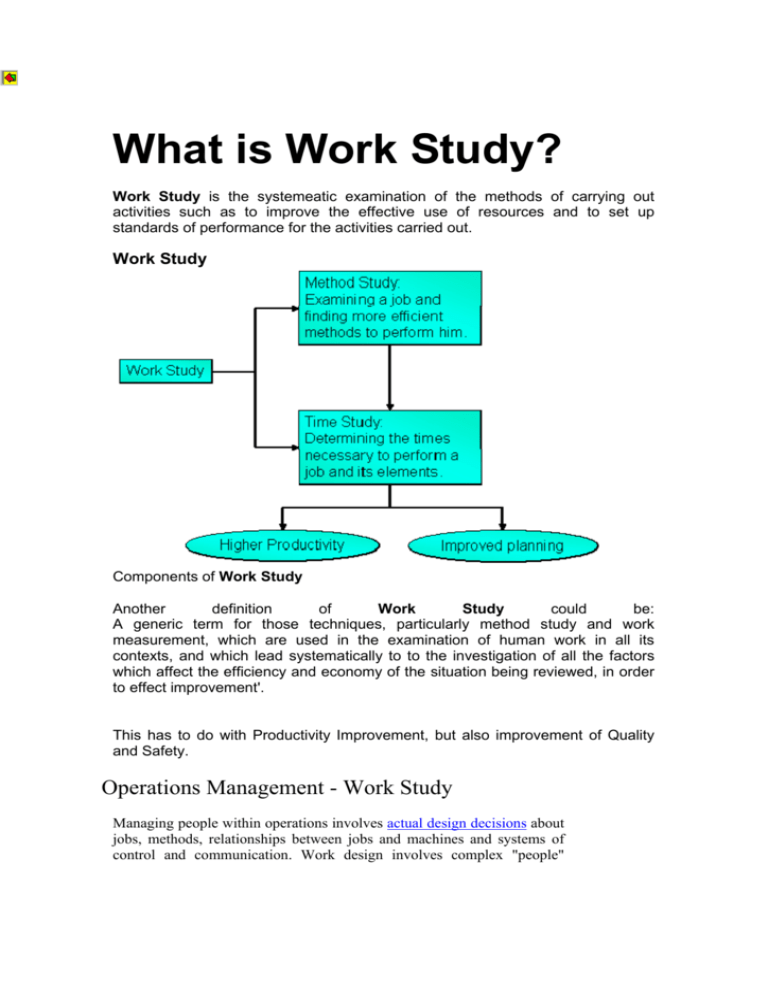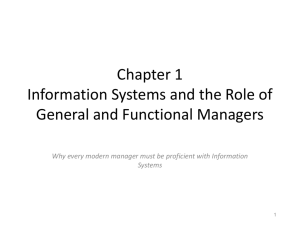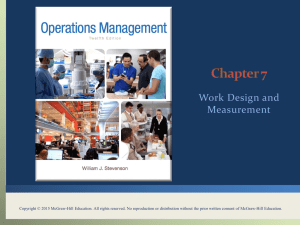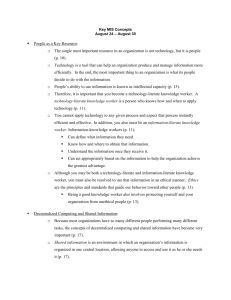What is Work Study?
advertisement

What is Work Study? Work Study is the systemeatic examination of the methods of carrying out activities such as to improve the effective use of resources and to set up standards of performance for the activities carried out. Work Study Components of Work Study Another definition of Work Study could be: A generic term for those techniques, particularly method study and work measurement, which are used in the examination of human work in all its contexts, and which lead systematically to to the investigation of all the factors which affect the efficiency and economy of the situation being reviewed, in order to effect improvement'. This has to do with Productivity Improvement, but also improvement of Quality and Safety. Operations Management - Work Study Managing people within operations involves actual design decisions about jobs, methods, relationships between jobs and machines and systems of control and communication. Work design involves complex "people" relationships between operative staff, supervisors and specialists e.g. engineering managers and staff who commission new machines and maintain them. Other specialists may co-ordinate health and safety systems or monitor performance and plan maintenance People are not mere extensions to machines or horsepower to be switched on and off. A worker's performance may be better than a machine's capability - yet a machine may outstrip the human being for many tasks. People can be hurt/injured physically by operating environments or trapped socially and psychologically in them/by them. How operational systems are designed and the jobs and performance relationships within them are of great operational, economic and social importance. In this context then work study is a collection of techniques used to examine work - what is done and how it is done - so that there is systematic analysis of all the elements, factors, resources and relationships affecting the efficiency and effectiveness of the work being studied. Considerable diplomacy and sensitivity is needed by the industrial engineer or operations manager who becomes involved in work study (or business process improvement) investigations. In the Path of F. W. Taylor Method study and work measurement are two principal activities of work study which originated in the work of F. W. Taylor (see Rose: 1978). FW's "scientific management" imperatives are: • investigate the work situation and identify weaknesses - where and why is poor performance happening? The "scientific" title for this approach to management means placing emphasis on • data gathering and rational analysis • certain narrow assumptions about the objectivity of efficiency criteria • the existence of direct, deterministic relationships between worker performance and incentive payments and • consideration of the worker to some extent as a machine. Thus we can evaluate and introduce improvements in operating methods. This includes type of equipment, its use, layout of operations, supply and use of materials, materials handling, work organisation, effectiveness of planning procedures and so on. Productivity improvement is the aim. • we can select staff with characteristics that fit the job, train and reward them using payment schemes the offer particular economic incentive by linking payment to measured performance. Such propositions are commonly the stuff of managerial populists and "how-to" texts on human resource management. Methods study Approach - is an analysis of ways of doing work. The memonic SREDIM (a common-sense heuristic or general problemsolving strategy) represents the method study stages 1. 2. 3. 4. 5. 6. select the tasks to study record the facts about it examine these develop a new method install/implement it maintain it Work measurement - involves assessing the time a job should take to do. Similar steps are involved as to method study 1. 2. 3. 4. 5. select the tasks record the facts analyse them calculate basic and standard times for the task agree the method and its related time In the 1950's and 1960's the work study officer or O&M Person (organisation and methods) gathered the data and gave advice. In the 1970's the titles evolved e.g. to that of management services officer. Work-study and methods study came within the scope of the industrial engineer. Today the techniques of method study are inclusive within the tool-kits and applications of the business systems analyst. The most modern application of some of the techniques of work study is the early 1990's managerial receipe; "business process re-engineering" i.e. re-designing business processes which have developed to the extent that they mismatch the needs of the situation today. However -- having said this - the scope for work study definition and evaluation is useful for operations managers in a general sense. Such roles require data on operational capacities and effectiveness and the use of time and resources. Methods need regular re-evaluation. Some may have evolved and changed over time to become disjointed, patch works that no longer fully serve requirements. The case may need to be put for more staff or new methods and equipment. Such arguments call for data and measurement. How many extra hours/people are needed? Why? What will the new method offer? Is it possible to change methods? What will be the costs/benefits? Thus the techniques, assumptions and weaknesses of work study reflect important know-how for the operations manager generally - and not just those working in engineering or manufacturing environments. However the assumptions, difficulties and limitations of the claims must be understood. Efficiency Indices Using data on measured work, unmeasured work and idle time we can attempt to derive effectiveness indices. Constable and New exemplify efficiency and effectiveness indices a. efficiency while performing measured work (ratio of standard/measured hours of work produced and the actual time taken) b. effectiveness which includes • accounting for work done for which no measured time exists. Such work is typically paid for by an agreed hourly/day rate i.e. there is no direct, measured relationship between pay and how much work is actually completed in that hour. Of course a supervisor may pass a judgment or state that the amount of work and its quality are inadequate. • recognition of possible idle time caused e.g. by management not allocating any work, supplier/materials delays, machine breakdowns etc. Conclusion? In simple terms work study measures work and defines (some) performance standards. There are many uses for time estimates for tasks. Operations managers can guess or assume that a job is done in the correct time (whatever that is!) or they can be systematic and use time data gathered by a systematic technique which has reasonable accuracy. Whether or not the worker likes it - pushed hard in trying to complete a job with very tight measured work standards which don't anticipate the knotty problem encountered with a particular task - is another matter. Work study/industrial engineers need time data to plan and evaluate production/transformation processes. Rewards systems need such data for performance related bonuses. Cost calculations need to incorporate operative and machine job times Costing systems reference work study data. Work study data contributes to: • • • Improved methods to raise output, quality, reduce wastage, enhance reliability and ensure safety. Standard time data contributes to capacity planning, scheduling, control of staff, asset utilisation and quality improvement. Service and after-sales method improvements may be obtained as well as process improvement and better raw materials usage. Implementation planning for product/service and process design requires a detailed understanding of methods and timings. In a distribution/transport system we can evaluate logistical efficiencies. We need to remember always that performance inefficiency may arise from many reasons outside of worker control - a cumbersome planning system, a slow computer system with heavy overheads, lack of investment or uninformed, disorganised management. It is crass to assume that the problems will only be due to staff inefficiencies or inappropriate methods.











